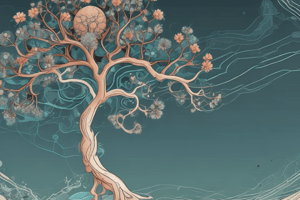Podcast
Questions and Answers
What is the study of the interactions between organisms and their environment?
What is the study of the interactions between organisms and their environment?
- Biochemistry
- Ecology (correct)
- Microbiology
- Botany
What is the process by which cells produce their own food?
What is the process by which cells produce their own food?
- Photosynthesis (correct)
- Cell division
- Metabolism
- Cell signaling
What is the term for the variety of different species, genes, and ecosystems that make up an ecosystem?
What is the term for the variety of different species, genes, and ecosystems that make up an ecosystem?
- Genetic diversity
- Species diversity
- Ecosystem diversity
- Biodiversity (correct)
Flashcards are hidden until you start studying
Study Notes
Branches of Biology
- Botany: study of plants
- Zoology: study of animals
- Microbiology: study of microorganisms
- Ecology: study of interactions between organisms and their environment
- Evolutionary biology: study of evolution and diversity of life
- Biochemistry: study of chemical processes in living organisms
- Biophysics: study of physical principles underlying biological processes
- Molecular biology: study of structure and function of biological molecules
Cell Biology
- Cell structure:
- Plasma membrane
- Cytoplasm
- Nucleus
- Mitochondria
- Endoplasmic reticulum
- Ribosomes
- Cell functions:
- Metabolism
- Photosynthesis
- Cell division (mitosis, meiosis)
- Cell signaling
- Cell death (apoptosis)
Genetics
- Mendelian genetics:
- Laws of inheritance (segregation, independent assortment)
- Dominant and recessive traits
- Genotype and phenotype
- Molecular genetics:
- DNA structure (double helix)
- DNA replication
- Gene expression (transcription, translation)
- Mutations and genetic variation
Evolution
- Mechanisms of evolution:
- Natural selection
- Genetic drift
- Gene flow
- Mutation
- Evidence for evolution:
- Fossil record
- Comparative anatomy
- Molecular biology (DNA and protein sequences)
- Biogeography
Ecosystems
- Components of ecosystems:
- Abiotic factors (light, temperature, water, nutrients)
- Biotic factors (organisms)
- Energy flow:
- Producers (autotrophs)
- Consumers (heterotrophs)
- Decomposers
- Nutrient cycling:
- Carbon cycle
- Nitrogen cycle
- Water cycle
Biodiversity
- Types of biodiversity:
- Species diversity
- Genetic diversity
- Ecosystem diversity
- Importance of biodiversity:
- Ecosystem services (pollination, pest control)
- Medicinal resources
- Food security
- Climate change mitigation
Branches of Biology
- Botany studies plants
- Zoology studies animals
- Microbiology studies microorganisms
- Ecology studies interactions between organisms and their environment
- Evolutionary biology studies evolution and diversity of life
- Biochemistry studies chemical processes in living organisms
- Biophysics studies physical principles underlying biological processes
- Molecular biology studies structure and function of biological molecules
Cell Biology
- Cell structure consists of plasma membrane, cytoplasm, nucleus, mitochondria, endoplasmic reticulum, and ribosomes
- Cell functions include metabolism, photosynthesis, cell division (mitosis, meiosis), cell signaling, and cell death (apoptosis)
Genetics
- Mendelian genetics involves laws of inheritance (segregation, independent assortment), dominant and recessive traits, and genotype and phenotype
- Molecular genetics involves DNA structure (double helix), DNA replication, gene expression (transcription, translation), and mutations and genetic variation
Evolution
- Mechanisms of evolution include natural selection, genetic drift, gene flow, and mutation
- Evidence for evolution includes fossil record, comparative anatomy, molecular biology (DNA and protein sequences), and biogeography
Ecosystems
- Components of ecosystems include abiotic factors (light, temperature, water, nutrients) and biotic factors (organisms)
- Energy flow involves producers (autotrophs), consumers (heterotrophs), and decomposers
- Nutrient cycling includes carbon cycle, nitrogen cycle, and water cycle
Biodiversity
- Types of biodiversity include species diversity, genetic diversity, and ecosystem diversity
- Importance of biodiversity includes ecosystem services (pollination, pest control), medicinal resources, food security, and climate change mitigation
Studying That Suits You
Use AI to generate personalized quizzes and flashcards to suit your learning preferences.




